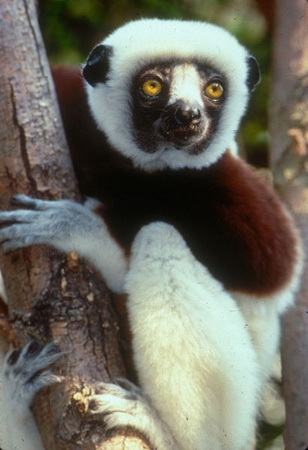Coquerel's Sifaka (Propithecus coquereli) Range: Madagascar (off the eastern coast of Africa)
Habitat: Forests
Conservation Status: Endangered
Scientific Name: Propithecus coquereli
The Animal that "Named" Itself
The sifaka is a type of lemur, a group of primitive primates found only in Madagascar. It's named after the alarm cry it makes when it sees an enemy (shee-fa'-ka).
There are three species, or types, of sifakas and some of those are divided into multiple subspecies. Coquerel's sifaka (the kind we have at the Saint Louis Zoo) is a subspecies of Verreaux's sifaka.
Looks Before Leaping
Coquerel's sifakas have a mostly white coat, with maroon patches on the chest and the front of the thighs and arms. The face is black and furless, except for a patch of white hair on the muzzle.
Sifakas are some of the largest living lemurs. An adult Coquerel's sifaka is usually about 20 inches from head to rump -- plus another 16 to 24 inches for the tail. The average weight is about 11 pounds.
These primates have a body designed for their arboreal (tree-dwelling) lifestyle. But unlike many primates, sifakas don't rely on their arms for swinging through trees. In fact, their arms are short and their range of motion is limited. Rather than swinging, sifakas leap between trees using their long, powerful back legs.
When they're on the ground, sifakas also move in an unusual but endearing way. They perform a skipping "dance" on their hind legs, while holding out their arms for balance.
Strictly Vegetarian
Sifakas are plant-eaters. Leaves are their favorite food, and make up most of their diet in the dry season (along with tree bark). In the wet season these primates also eat fruits and flowers. They find much of their food in the treetops, but also occasionally search for food on the ground.
When eating, sifakas rarely use their hands to handle their meal. Instead, they usually grab the food directly with their mouth.
Bringing Up Baby
For Coquerel's sifakas in the wild, the mating season as a whole runs from January to March. But females in a given group are in estrus (in heat) for only a very brief time -- around 40 hours. They're also choosy about their mates, accepting only dominant males. Among males, fighting for dominance is frequent and can lead to serious injuries.
Some five-and-a-half months after mating, females give birth to a single baby -- tiny, black, and furry. The little ones hold on to mom's belly for about a month, then they "graduate" to riding on her back. After five or six months, the young are weaned.
Group Living and Border Fighting
Except for breeding season, Coquerel's sifakas live in peaceful groups. Each troop commonly has three to six individuals -- usually an equal number of adult males and females and just one infant. Females are dominant to males, and generally remain with their birth group. Males, on the other hand, change groups several times during their lives.
Within a troop, there is a lot of daytime activity, including playing and grooming. When group members disperse to find food, they keep in contact with special calls. They also have alarm cries to warn each other of approaching enemies. At night, they avoid predators by sleeping in the treetops.
Every group has a home range, which overlaps with those of neighboring groups. The primates mark their domains with urine and with scent from a gland located on the front of the throat. When two groups confront each other, aggression is usually limited to displays or chases.
Saving Sifakas
Like many other types of sifaka, the Coquerel's sifaka is in danger of extinction in the wild. These animals suffer from continued habitat loss, as their forest homes are logged for timber and turned into farmland.
Is anything being done to help these primates? Yes! The Saint Louis Zoo is working to save sifakas and other lemurs in the wild.
Fun facts
With their powerful hind legs, sifakas can propel themselves more than 30 feet in a single jump!
A group of sifakas moves about one-half mile a day and covers its entire home range in 10 to 20 days.
Class: Mammalia
Order: Primates
Family: Indriidae
http://www.stlzoo.org/animals/abouttheanimals/mammals/lemursmonkeysapes/coquerelssifaka.htm
